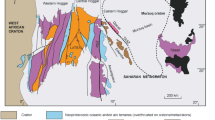Abstract
The large jacupirangite dyke at Kodal was first found by W.C. Brögger (1933) who published one chemical analysis of the rock. Recent investigations of the dyke as a potential ore body, including diamond-drilling operations, have shown that it is about 20 m wide and 2 km long. It strikes approximately E–W and has a general dip of 80 °S, cutting through larvikite and nordmarkite of the Oslo Permian Igneous Province. The jacupirangite has an average modal composition (volume percent): apatite 24, magnetite 37, ilmenite 9, pyroxene 25, amphibole and biotite 5. The iron-titanium oxides and apatite cement the pyroxene in a typical igneous texture. The Kodal dyke and other jacupirangites in adjoining areas of the Oslo Igneous Province all show a eutectic mixture of iron-titanium oxides and apatite which is assumed to form an immiscible liquid with silicate melts of monzonitic composition. This is assumed to be a possible explanation for the formation of the jacupirangites in the Oslo region.
Zusammenfassung
Der große Jacupirangit-Gang in Kodal wurde erstmals von C. W. Brögger (1933) gefunden, der eine chemische Analyse von diesem Gestein publiziert hat. Neuere Untersuchungen an diesem Gang im Hinblick auf eine potentielle Erzlagerstätte, bei denen auch Diamant-Bohrungen eingesetzt worden sind, haben ergeben, daß der Gang etwa 20 m mächtig und 2 km lang ist. Er streicht bei einem durchschnittlichen Fallen von 80 °S annähernd O–W, wobei er Larvikite und Nordmarkite der permischen Oslo-Eruptivprovinz durch-schneidet. Die durchschnittliche modale Zusammensetzung des Jacupirangites besteht (in Volumenprozent) aus: Apatit 24%, Magnetit 37%, Ilmenit 9%, Pyroxen 25%, Amphibol und Biotit 5%. Die Eisen-Titan-Oxide und der Apatit verkitten die Pyroxene unter Bildung einer typischen Eruptivstruktur. Der Kodal-Gang und die anderen Jacupirangite der angrenzenden Oslo-Eruptivprovinz lassen alle ein eutektisches Gemenge von Eisen-Titan-Oxiden und Apatit erkennen, von dem wir annehmen, daß es eine unlösliche Schmelze neben Silikatschmelzen monzonitischer Zusammensetzung bildete. Aus dieser Annahme ergibt sich eine Deutungsmöglichkeit für das Auftreten der Jacupirangite im Oslo Gebiet.
Similar content being viewed by others
References
Bose, M. K.: Petrology of the sörkedalite — A primitive rock from the Alkali Igneous Province of Oslo. Vid.-Akad. Skr. I. Mat. Nat. Kl. Ny Serie, No, 1–28 (1969).
Brögger, W. C.: Die Eruptivgesteine des Kristianiagebietes. III. Das Ganggefolge des Laurdalits. Vid.-Akad. Skr. I. Mat. Nat. Kl. 1897. No 6, 1–377 (1898).
Brögger, W. C.Die Eruptivgesteine des Oslogebietes. VII. Vid.-Akad. Skr. I. Mat. Nat. Kl. No. 1, 78–80 (1933).
Buddington, A. F., Fahey, J., Vlisidis, A.: Thermometric and Petrogenetic significance of titaniferous magnetite. Am. J. Sci. 253, 497–532 (1955).
Buddington, A. F. Lindsley, D. H.: Iron-Titanium Oxide Minerals and Synthetic Equivalents. J. Petrol. 5, 310–357 (1964).
Derby, O. A.: On the Magnetite Ore Districts of Jacupiranga and Ipanema, Sao Paulo, Brazil. Am. J. Sci. Art. XXXVII, 311–321 (1891).
Fischer, R.: Entmischungen in Schmelzen aus Schwermetalloxyden, Silikaten und Phosphaten. Neues Jahrb. Mineral. 81 A, 315–364 (1950).
Haggerty, S. E.: The Laco Magnetite Lava Flow, Chile. Annual Report of the Director, Geophysical Laboratory, 1968–1969. Washington, 1970, 329–330 (1970).
Johannsen, A.: A descriptive Petrology of the Igneous Rocks. Vol. IV. Chicago: The University of Chicago Press 1937.
Neumann, H., Bergstøl, S.: Pyrophanite in the Southern Part of the Oslo Area. Norsk Geol. Tidsskr. 44, 39–42 (1964).
Nielsen, N.-A.: Kodal forekomsten. Et industri-objekt i Vestfold, Tidsskr. Kjemi, Bergv. Metallurgi 27, 73–76 (1967).
Oftedahl, Chr.: Guide to excursion A 11 and C 7. International Geological Congress, Norden 1960: Permian Igneous Rocks of the Oslo Graben, Norway, 1–23 (1959).
Park, C. F.: A magnetite “flow” in Northern Chile. Economic Geol. 56, 431–436 (1961).
Philpotts, A. R.: Origin of certain Iron-Titanium Oxide and Apatite Rocks. Econ. Geol. 62, 303–315 (1967).
Ramdohr, P.: The ore minerals and their intergrowth, 1174 p. Oxford-London-Edinburgh-New York - Toronto - Sidney - Paris - Braunschweig: Pergamon Press 1969.
Steinnes, E.: Determination of some Lanthanide Elements in apatites by instrumental neutron activation analyses. Kjeller Research Establishments, Kjeller report 1967, 1–7 (1967).
Watson, T. L., Jaber, S.: Geology of the titanium and apatite deposits of Virginia. Virginia Geol. Surv. Bull. 111-a (1913).




